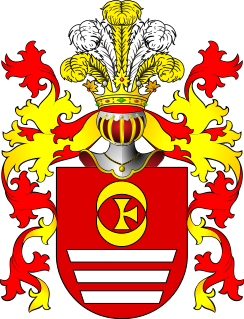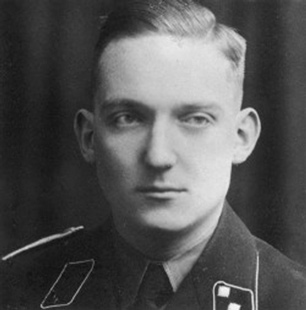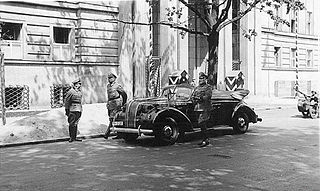Wymysorys, also known as Vilamovian, Vilamovician or Wilamowicean, is a West Germanic language spoken in the small town of Wilamowice, Poland, on the border between Silesia and Lesser Poland, near Bielsko-Biała. It is considered an endangered language. There are probably fewer than 20 native users of Wymysorys, virtually all bilingual; the majority are elderly.

Radwan is a Polish knights' clan (ród) and a Polish coat of arms used by the szlachta (noble) families within the clan.

Sas or Szász is a Central European coat of arms. It was borne since the medieval period by several Transylvanian-Saxon Hungarian, Ruthenian, Ukrainian, and Polish-Lithuanian noble families. The house was once a mighty princely and ducal house with origins in Saxony, Transylvania, Hungary and Ruthenia.

Korwin is a Polish coat of arms. It was used by several szlachta families in the times of the Polish-Lithuanian Commonwealth.

The Jauch family of Germany is a Hanseatic family which can be traced back till the Late Middle Ages. At the end of the 17th century the family showed up in the Free Imperial and Hanseatic City of Hamburg. The members of the family acted as long-distance merchants. They became hereditary grand burghers of Hamburg and were Lords of Wellingsbüttel Manor – nowadays a quarter of Hamburg.

Svyatopolk-Mirsky is a family of Russian and Polish nobility that originated from present-day northwestern Belarus.

Tomasz Strzembosz was a Polish historian and writer who specialized in the World War II history of Poland. He was a professor at the Polish Academy of Sciences Institute of Political Studies, in Warsaw; and, from 1991, at the John Paul II Catholic University of Lublin. Strzembosz was a resident of Warsaw, Poland.

Wysoczański plural: Wysoczańscy is the surname of a Polish szlachta (nobility) family, which traces its lineage back to Comes Vane Valachus who was granted land in 1431 by Polish King Ladislaus II. Jagiełło. Hereditary Chevaliers of Galicia (“Ritter”) since 1782.

Józef Jan Gosławski was a Polish sculptor and medallic artist. He was a designer of coins, monuments and medals. Laureate of many artistic competitions; decorated with the Silver Cross of Merit.

Kur is a Polish coat of arms. It was used by several noble families forming a Clan of Kur in the times of the Kingdom of Poland and the Polish-Lithuanian Commonwealth. It is noted during the reign of the Jagiellon dynasty and illustrated with its original name in the work of Bartosz Paprocki "Herby Rycerstwa Polskiego" in 1584. Furthermore, it is published in the work of Szymon Okolski in 1641. and several other publications

Hermann Schaper, was a German SS functionary during the Nazi era. He was a Holocaust perpetrator responsible for atrocities committed by the Einsatzgruppen in German-occupied Poland and the Soviet Union and was convicted after the war of numerous war crimes.

Wolfgang Birkner was a German SS functionary with the rank of SS-Hauptsturmführer, and the Holocaust perpetrator in World War II. Birkner served as the KdS Warschau in Warsaw following the German invasion of Poland in 1939.
Dr. Alexandra Maria Catharina von Dyhrn, was a German genealogist, author and the first woman in the province of Silesia to earn a doctorate in History.
Henry Picker was a lawyer, stenographer and author who co-transcribed and first published transcripts of Adolf Hitler's informal talks, known colloquially as the Table Talk.

Feliks Walezjusz Władysław Łubieński was a Polish politician, jurist, Minister of Justice in the Grand Duchy of Warsaw, starosta of Nakieł, a member of the Friends of the Constitution and a Prussian count. With the Code Napoleon, he introduced civil marriage and divorce in traditionally Catholic Poland.
The modern Poland–Russia border is a nearly straight-line division between the Republic of Poland and the Russian Federation semi-exclave of Kaliningrad Oblast, a region not connected to the Russian mainland. It is currently 232 kilometres (144 mi) long. Its current location and size were decided as part of the aftermath of World War II. In 2004 it became part of the boundary of the European Union and Commonwealth of Independent States.

Count Georg Wassilko von Serecki, descended from an old Modavian boyar family, was an Austro-Hungarian-born ethnic Romanian statesman, Landeshauptmann of the Duchy of Bucovina and hereditary member of the Herrenhaus, the Upper House of the Imperial Council of Austria.

The mansion/manor home (dwór) in Michałowice village, Lesser Poland province, Poland, designed by prominent architect Teodor Talowski, and reminiscent of a suburban villa, was constructed in the years 1892-1897, for the noble (szlachta) family, Żądło-Dąbrowski z Dąbrówki herbu Radwan, who moved from Mazovia, Poland.
Dalej jest noc: losy Żydów w wybranych powiatach okupowanej Polski, co-edited by Jan Grabowski and Barbara Engelking, and co-authored with 7 other Center members, is a two-volume study published in 2018 by the Polish Center for Holocaust Research in Warsaw, Poland. The 1,600-page study covers 8 and a half of 63 Polish counties in the General Government established by Germany in World War II. The study identifies small Polish towns as having been particularly dangerous "death traps" for Jews in hiding.













